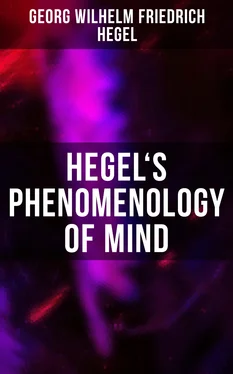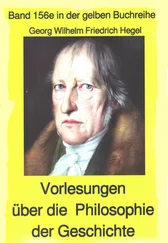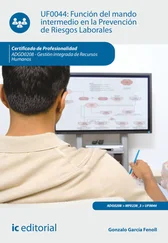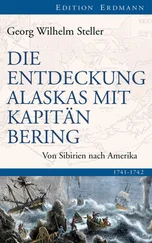Georg Wilhelm Friedrich Hegel - Hegel's Phenomenology of Mind
Здесь есть возможность читать онлайн «Georg Wilhelm Friedrich Hegel - Hegel's Phenomenology of Mind» — ознакомительный отрывок электронной книги совершенно бесплатно, а после прочтения отрывка купить полную версию. В некоторых случаях можно слушать аудио, скачать через торрент в формате fb2 и присутствует краткое содержание. Жанр: unrecognised, на английском языке. Описание произведения, (предисловие) а так же отзывы посетителей доступны на портале библиотеки ЛибКат.
- Название:Hegel's Phenomenology of Mind
- Автор:
- Жанр:
- Год:неизвестен
- ISBN:нет данных
- Рейтинг книги:4 / 5. Голосов: 1
-
Избранное:Добавить в избранное
- Отзывы:
-
Ваша оценка:
- 80
- 1
- 2
- 3
- 4
- 5
Hegel's Phenomenology of Mind: краткое содержание, описание и аннотация
Предлагаем к чтению аннотацию, описание, краткое содержание или предисловие (зависит от того, что написал сам автор книги «Hegel's Phenomenology of Mind»). Если вы не нашли необходимую информацию о книге — напишите в комментариях, мы постараемся отыскать её.
Hegel's Phenomenology of Mind — читать онлайн ознакомительный отрывок
Ниже представлен текст книги, разбитый по страницам. Система сохранения места последней прочитанной страницы, позволяет с удобством читать онлайн бесплатно книгу «Hegel's Phenomenology of Mind», без необходимости каждый раз заново искать на чём Вы остановились. Поставьте закладку, и сможете в любой момент перейти на страницу, на которой закончили чтение.
Интервал:
Закладка:
This determinate characteristic, which constitutes the essential character of the thing and distinguishes it from all others, is now so defined that thereby the thing, stands in opposition to others, but must therein preserve itself for itself ( für sich ). It is, however, a thing, a self-existent “one”, only so far as it does not stand in relation to others. For in this relation, the connection with another is rather the point emphasized, and connection with another means giving up self-existence, means ceasing to have a being on its own account. It is precisely through the absolute character and its opposition that the thing relates itself to others, and is essentially this process of relation, and only this. The relation, however, is the negation of its independence, and the thing collapses through its own essential property.
The necessity of the experience which consciousness has to go through in finding that the thing is destroyed just by the very characteristic which constitutes its essential nature and its distinctive existence on its own account, may, as regards the bare principle it implies, be shortly stated thus. The thing is set up as having a being of its own, as existing for itself, or as an absolute negation of all otherness; hence it is absolute negation merely relating itself to itself. But this kind of negation is the cancelling and superseding of itself, or means that it has its essential reality in an other.
In point of fact the determination of the object, as it (the object) has turned out, contains nothing else. It aims at having an essential property, constituting its bare existence for itself, but with this bare self-existence it means also to embrace and contain diversity, which is to be necessary, but is at the same time not to constitute its essential characteristic. But this is a distinction that only exists in words; the nonessential, which has all the same to be necessary, cancels its own meaning, or is what we have just called the negation of itself.
With this the last qualifying “in-so-far”, which separated self-existence and existence for another, drops away altogether. The object is really in one and the same respect the opposite of itself-for itself “so far as” it is for another, and for another “so far as” it is for itself. It is for itself, reflected into self, one; but all this is asserted along with its opposite, with its being for another, and for that reason is asserted merely to be superseded. In other words, this existence for itself is as much unessential as that which alone was meant to be unessential, viz. the relation to another.
By this process the object in its pure characteristics, in those features which were to constitute its essential nature, is superseded, just as the object in its sensible mode of existence became transcended. From being sensible it passed into being a universal; but this universal, because derived from sense, is essentially conditioned by it, and hence is, in general, not a genuine self-identical universality, but one affected with an opposition. For that reason this universality breaks up into the extremes of singleness and universality, of the one of the properties and the “also” of the free constituents or matters”. These pure determinations appear to express the essential nature itself; but they are merely a self-existence which is fettered at the same time with existence for an other. Since, however, both essentially exist in a single unity, we have before us now unconditioned absolute universality ; and it is here that consciousness first truly passes into the sphere of Understanding , of Intelligence.
Sensible singleness thus disappears in the dialectic process of immediate certainty, and becomes universality, but merely sensuous universality. The stage of “meaning” has vanished, and perceiving takes the object as it inherently is in itself, or, put generally, as a universal. Singleness, therefore, makes its appearance there as true singleness, as the inherent nature of the “one”, or as reflectedness into self. This is still, however, a conditioned self-existence alongside which appears another self-existence, the universality opposed to singleness and conditioned by it. But these two contradictory extremes are not merely alongside one another, but within one unity; or, what is the same thing, the common element of both, self-existence, is entirely fettered to its opposite, i.e. is, at the same time, not an existence-for-self. The sophistry of perception seeks to save these moments from their contradiction, tries to keep them fixed by distinguishing between “aspects”, by using terms like “also” and “so far as”, and seeks in like manner to lay hold on the truth by distinguishing the unessential element from an essential nature opposed thereto. But these expedients, instead of keeping away deception from the process of apprehension, prove rather to be of no avail at all; and the real truth, which should be got at through the logic of the perceptual process, proves to be in one and the same “aspect” the opposite (of what those expedients imply), and consequently to have as its essential content undifferentiated and indeterminate universality.
These empty abstractions of “singleness” and antithetic “universality”, as also of “essence”, that is attended with a “non-essential” element, an element which is all the same “necessary”, are powers the interplay of which constitutes perceptual understanding, often called “sound common sense” ( Menschenverstand ). This “healthy common sense”, which takes itself to be the solid substantial type of conscious life, is, in its process of perception, merely the sport of these abstractions; it is always poorest where it means to be richest. In that it is tossed about by these unreal entities, bandied from one to the other, and by its sophistry endeavors to affirm and bold fast alternately now one, then the exact opposite, it sets itself against the truth, and imagines philosophy has merely to do with “things of the intellect” ( Gedankendinge ), merely manipulates “ideas”. As a matter of fact, philosophy does have to do with them, too, and knows them to be the pure essential entities, the, absolute powers and ultimate elements. But in doing so, philosophy knows them at the same time in their determinate and specific constitution, and is, therefore, master over them; while that perceptual understanding takes them for the real truth, and is led by them from one mistake to another. It does not get the length of being, aware that there are such simple essentialities operating within it and dominating its activity; it thinks it has always to do with quite solid material and content; just as sense-certainty is unaware that its essence is the empty abstraction of pure being. But in point of fact it is these essential elements in virtue of which perceptual understanding makes its way hither and thither through every kind of material and content; they are its principle of coherence and control over its varied material; they alone are what constitutes for consciousness the essence of sensuous things, what determines their relations to consciousness; and they are that in the medium of which the process of perceiving, with the truth it contains, runs its course. The course of this process, a perpetual alternate determining of the truth and superseding of this determination, constitutes, properly speaking, the constant everyday life and activity of perceptual intelligence, of the consciousness that thinks it lives and moves in the truth. In that process it advances, without halt or stay, till the final result is reached, when these essential ultimate elements or determinations are all alike superseded; but in each particular moment it is merely conscious of one given characteristic as the truth, and then, again, of the opposite. It no doubt suspects their unessentiality; and, to save them from the impending danger, it takes to the sophistry of now asserting to be true what it had itself just affirmed to be not true. What the nature of these untrue entities really wants to force this understanding to do — viz. to bring together and thereby cancel and transcend the ideas about that “universality” and “singleness”, about that “‘essentiality” which is necessarily connected with an “unessentiality” and about an “unessential” that is yet “necessary”— understanding “ strives to resist by leaning for support on the so qualifying terms “in-so-far”, “a difference of aspect”, or by making itself answerable for one idea in order to keep the other separate and preserve it as the true one. But the very nature of these abstractions brings them together as they are and of their own accord. “Sound common sense” is the prey of these abstractions; they carry understanding round in their whirling circle. When understanding tries to give them truth by at one time taking their untruth upon itself, while at another it calls their deceptiveness a mere appearance due to the uncertainty and unreliability of things, and separates the essential from an element which is necessary to them, and yet is to be unessential, holding the former to be their truth as against the latter:— when understanding takes this line, it does not secure them their truth, but convicts itself of untruth.
Читать дальшеИнтервал:
Закладка:
Похожие книги на «Hegel's Phenomenology of Mind»
Представляем Вашему вниманию похожие книги на «Hegel's Phenomenology of Mind» списком для выбора. Мы отобрали схожую по названию и смыслу литературу в надежде предоставить читателям больше вариантов отыскать новые, интересные, ещё непрочитанные произведения.
Обсуждение, отзывы о книге «Hegel's Phenomenology of Mind» и просто собственные мнения читателей. Оставьте ваши комментарии, напишите, что Вы думаете о произведении, его смысле или главных героях. Укажите что конкретно понравилось, а что нет, и почему Вы так считаете.












